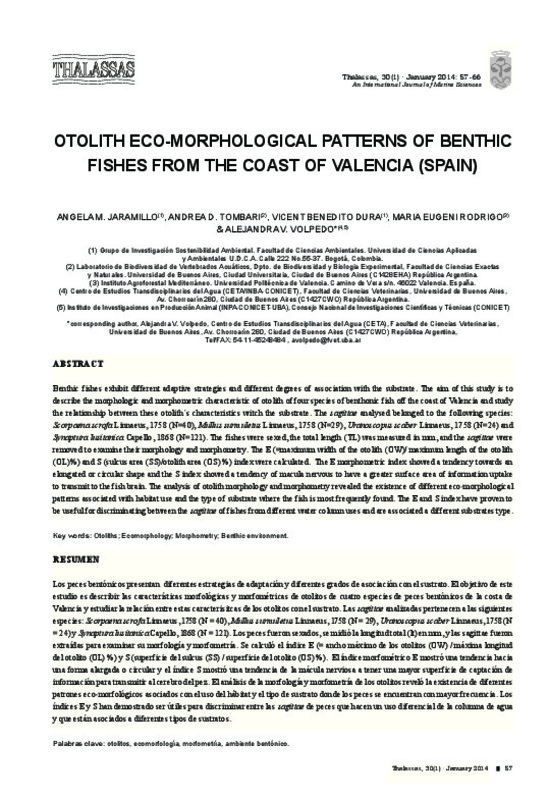|
Resumen:
|
[EN] Benthic fishes exhibit different adaptive strategies and different degrees of association with the substrate. The aim of this study is to describe the morphologic and morphometric characteristic of otolith of four ...[+]
[EN] Benthic fishes exhibit different adaptive strategies and different degrees of association with the substrate. The aim of this study is to describe the morphologic and morphometric characteristic of otolith of four species of benthonic fish off the coast of Valencia and study the relationship between these otolith's characteristics witch the substrate. The sagittae analysed belonged to the following species: Scorpaena scrofa Linnaeus, 1758 (N=40), Mullus surmuletus Linnaeus, 1758 (N=29), Uranoscopus scaber Linnaeus, 1758 (N=24) and Synaptura hisitanica Capello, 1868 (N=121). The fishes were sexed, the total length (TL) was measured in mm, and the sagittae were removed to examine their morphology and morphometry. The E (=maximum width of the otolith (OW)/maximum length of the otolith (OL)%) and S (sulcus area (SS)/otolith area (OS) %) index were calculated. The E morphometric index showed a tendency towards an elongated or circular shape and the S index showed a tendency of macula nervous to have a greater surface area of information uptake to transmit to the fish brain. The analysis of otolith morphology and morphometry revealed the existence of different eco-morphological patterns associated with habitat use and the type of substrate where the fish is most frequently found. The E and S index have proven to be useful for discriminating between the sagittae of fishes from different water column uses and are associated a different substrates type.
[-]
[ES] Los peces bentónicos presentan diferentes estrategias de adaptación y diferentes grados de asociación con el sustrato. El objetivo de este estudio es describir las características morfológicas y morfométricas de ...[+]
[ES] Los peces bentónicos presentan diferentes estrategias de adaptación y diferentes grados de asociación con el sustrato. El objetivo de este estudio es describir las características morfológicas y morfométricas de otolitos de cuatro especies de peces bentónicos de la costa de Valencia y estudiar la relación entre estas caracterisitcas de los otolitos con el sustrato. Las sagittae analizadas pertenecen a las siguientes especies: Scorpaena scrofa Linnaeus, 1758 (N = 40), Mullus surmuletus Linnaeus, 1758 (N = 29), Uranoscopus scaber Linnaeus, 1758 (N = 24) y Synaptura lusitanica Capello, 1868 (N = 121). Los peces fueron sexados, se midió la longitud total (lt) en mm, y las sagittae fueron extraídas para examinar su morfología y morfometría. Se calculó el índice E (= ancho máximo de los otolitos (OW) / máxima longitud del otolito (OL) %) y S (superficie del sulcus (SS) / superficie del otolito (OS) %). El índice morfométrico E mostró una tendencia hacia una forma alargada o circular y el índice S mostró una tendencia de la mácula nerviosa a tener una mayor superficie de captación de información para transmitir al cerebro del pez. El análisis de la morfología y morfometría de los otolitos reveló la existencia de diferentes patrones eco-morfológicos asociados con el uso del hábitat y el tipo de sustrato donde los peces se encuentran con mayor frecuencia. Los índices E y S han demostrado ser útiles para discriminar entre las sagittae de peces que hacen un uso diferencial de la columna de agua y que están asociados a diferentes tipos de sustratos.
[-]
|
|
Agradecimientos:
|
We are grateful to the “Conselleria de Territori I Habitatge. Generalitat Valenciana”, to the Universidad de Buenos Aires (UBACYT 20620110100007), to the National Scientific and Technical Research Council (CONICET) and ...[+]
We are grateful to the “Conselleria de Territori I Habitatge. Generalitat Valenciana”, to the Universidad de Buenos Aires (UBACYT 20620110100007), to the National Scientific and Technical Research Council (CONICET) and ANPCYT (PICT N° 2010-1372) for the
financial support to this project. The authors grateful to C. Assis for critical revision of manuscript and for their comments, and G.E. Comte for the technical support in images analyzed.
[-]
|







